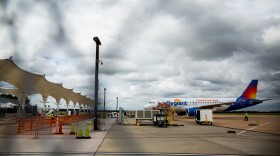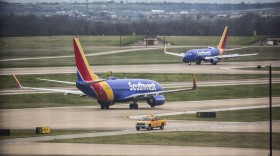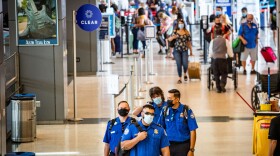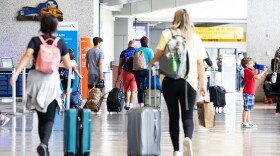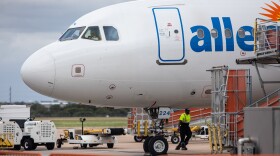The wait to get through TSA security at Austin-Bergstrom International Airport has improved in recent weeks, airport officials say.
Lines are no longer stretching through the terminal and out onto the sidewalk as they were in March, when ABIA Executive Director Jacqueline Yaft pleaded with the Transportation Security Administration to send more officers.
"Right now, the latest reports are that we're maintaining the [maximum] 30-minute wait time, which is really good," Yaft told members of a city commission that oversees the publicly owned airport.
Fifty additional TSA officers temporarily sent to Austin's airport have had their deployment extended through the summer. U.S. Customs and Border Protection also sent additional canine units to help speed up security screening.

The TSA is now offering retention bonuses in Austin on top of hiring bonuses. And more advanced screening machines will be installed at ABIA in August, part of a nationwide effort ahead of a summer travel season that's expected to be one of the busiest ever.
TSA officers at ABIA are working six days a week in many cases, part of an overtime system that becomes mandatory if not enough people volunteer. The union representing TSA workers warns mandatory overtime makes it harder for agents to do their jobs.

"It would be an insufficient amount of rest to be able to perform your job efficiently, so that can become a problem," said Hydrick Thomas, who represents TSA workers on behalf of the the American Federation of Government Employees. "Now, they're going to get burnt out."
Passengers have been arriving earlier as word spreads about wait times, officials said. The busiest hours are typically from 4 a.m. to 8 a.m. when the most flights are scheduled. Airlines have even started opening ticket counters before TSA agents begin screening people at 3:30 a.m.
Even though lines are less apocalyptic than they were on March 28 — the Monday after three major sporting events in Austin — travelers are still facing delays, and the airport is expected to get even busier next month.
Passengers also have reported long lines for food and drink retailers and rental car businesses. Others have complained about being stuck in their planes on the airfield because a gate isn't available.

"It seems like I get every day [complaints that] somebody's flight is on the ground and they can't come to the gate. Or there are gates that are empty, and the airline is delayed because they don't have a gate," Airport Commissioner Wendy Price Todd said at a public meeting this week.
Airport officials said planes can be stuck waiting for gates because of airline staffing shortages or flights arriving too early or too late.
"There's a lot of reasons why that could be happening," Yaft said.
Passenger traffic will pick up in June because more flights are scheduled out of Austin. Air Canada starts new nonstop service to Vancouver four times a week on June 1. American will begin flights in June to Asheville, N.C.; Belgrade, Montana; Santa Ana, California; Cozumel, Mexico; and Montego Bay, Jamaica. Virgin Atlantic will start new nonstop service to London four times a week on May 25.

Overall, the number of seats available on flights out of Austin is expected to increase by 29% compared to June 2019, the last blockbuster year for ABIA.
Airport officials are forecasting a record-breaking 22 million passengers this year, even more than were expected just a few months ago.
To deal with the continued growth, Austin's airport has a $4 billion expansion and development plan to increase capacity for flights and passengers.
Airport staff last week secured $400 million in loans to fund some of the more immediate projects. The money will be repaid with airport revenue. Local property tax dollars don't pay for ABIA operations or infrastructure.
The airport bonds will pay for three more gates on the west side of the Barbara Jordan Terminal. Those are expected to be up and running by late 2024 or 2025.
More immediately, Gate 13, currently inactive, is being renovated for people who have to get off their planes on the tarmac when no other gates are available. Passengers would exit the aircraft and get on board a specially designed bus that would drive them to the gate. The Gate 13 project is scheduled to be completed next year.

Longer term, a new concourse is planned — connected by an underground pedestrian tunnel — that would start with at least 10 gates but could handle as many as 40.
But that project faces stiff resistance from the operator of the South Terminal. The facility, where Allegiant and Frontier operate, would have to be demolished to make space for the new concourse.
The expansion project will also increase TSA screening capacity by adding extra lanes to Checkpoint 3. That project is still being designed, so there's no final count on how many lanes would be added.




